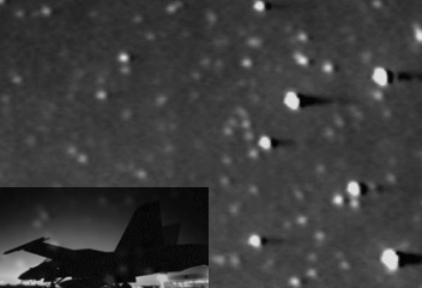Astronomy From An F-18

Explanation:
In an era of
blossoming
ground and space-based observatories,
astronomers are also pushing the envelope with airborne
instrumentation - successfully
capturing an asteroid occultation
from a high performance jet aircraft.
This blinking animation represents two digitized frames from inflight
data of
asteroid number 308, Polyxo, passing in front
of or
occulting a faint
star near the center of the field.
The camera used, known as the
SouthWest Ultraviolet Imaging System (SWUIS) -A,
was mounted in
the cockpit of a
NASA F/A-18 jet
(inset lower left).
A former US Navy fighter aircraft,
the F/A-18 was able to
maneuver to the precise position to record the occultation
while cruising above clouds and much of Earth's obscuring atmosphere.
Using the SWUIS-A data to time the
occultation will reveal
the size of the asteroid which is otherwise too small to be imaged
by even the orbiting
Hubble Space Telescope.
Future
SWUIS-A airborne missions may include a hunt for Vulcanoids,
a suspected population of small
asteroids
circling the Sun inside
the orbit of Mercury.
Authors & editors:
Robert Nemiroff
(MTU) &
Jerry Bonnell
(USRA)
NASA Web Site Statements, Warnings,
and Disclaimers
NASA Official: Jay Norris.
Specific
rights apply.
A service of:
LHEA at
NASA /
GSFC
& Michigan Tech. U.

